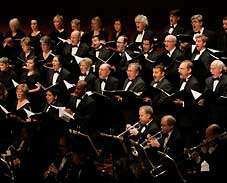|
Back
Ecstasy Extracted from the Equations New York
Isaac Stern Auditorium, Carnegie Hall
12/11/2011 -
Parallel Lives: Liszt and Busoni
Ferruccio Busoni: Piano Concerto in C, Opus 39
Franz Liszt: A Faust Symphony
Ryan MacPherson (Tenor), Piers Lane (Piano)
The Collegiate Chorale Singers, The American Symphony Orchestra, Leon Botstein (Conductor)

P. Lane (© Clive Barda)
The two hour-plus works conducted by Leon Botstein yesterday afternoon–one concerto and one symphony–only started with the title: “Parallel Lives: Liszt and Busoni”. In a way, both works were part of a Late Romantic musico-literary calculus.
Liszt’s 1858 Faust Symphony was of course based on Goethe’s drama, itself based on a 1580 semi-mythical story. But the Liszt work was equally inspired by Berlioz’ Damnation of Faust, written a decade before. Both composers dedicated their particular Fausts to each other.
The equation becomes more convoluted, since the Faust Symphony is alike in form to Tchaikovsky's Manfred Symphony, performed last week by the London Philharmonic Orchestra. This was inspired again by Berlioz’ form for Harold in Italy. Both poems were by Byron, and Byron’s Manfred was inspired by–you guessed it!–Goethe’s Faust!
To finish the biquadratic equation, we bring in their mutual friend, Robert Schumann. He was so intrigued by the Faust story that he wrote both a “dramatic poem” on Manfred and an oratorio based on Faust. The former was so good that Tchaikovsky initially refused to write his own Manfred Symphony.
These works, written over half a century, might be described as artistic incest.
(Less likely, the era's composers could have belonged to the same Book-of-the-Month club.)
Anyhow, the first piece on the program, Busoni’s only Piano Concerto had nothing to do with Faust. And yet, Busoni’s finest opera was Doktor Faustus! Friedrich Nietzsche described “the restless tormented intellectual-theorist Busoni as “Faustian”. Not to mention Busoni’s demonic transcription of Liszt’s own Mephisto Waltz. And to finish things, the choral study at the end of the Concerto could well have been written by Goethe.
Now that you are totally lost, back to this afternoon’s program. To succeed, Leon Botstein didn’t have to sell his soul to Lucifer, for the conductor’s musical understanding within the context of history, is without parallel. Granted, the American Symphony Orchestra is not New York’s finest. And granted, in the amorphous orchestration of the Piano Concerto, they could be fuzzy, never quite focused. But the soloist for the Concerto, Australian-born Piers Lane, was splendid.
Being that good in the Busoni does not make one a great pianist. Much of the music consists of endless cascades, runs up and down the scale, coating the entire piano with sounds and fury.
Perhaps Mr. Lane is another Horowitz or Ashkenazy. But what we heard here was what we expected to hear. Musical muscularity of the highest order. The man who revived the Busoni, John Ogdon, had those gigantic hands and huge arms that made the music seem easy. I am not aware of Mr. Lane’s digital measurements, but over an hour of non-stop playing was dynamic, irresistible and with elephantine strength.
Busoni had eclectic personae as a composer, but the Concerto was a holiday from Germanic austerity, and the Neapolitan/Sicilian bumptiousness was unforced, delightful. True, the last movement brought us back to Busoni’s mystic temperament, but the onstage voices of the Collegiate Chorale Singers were powerful enough to send down the proverbial shivers.
Busoni had specified that the singers be offstage, but doubtless Mr. Botstein felt they could make their effect from the back of the stage, which they did.
The Liszt Faust Symphony was not as easy to admire. Like Tchaikovsky’s Manfred, conducted by Vladimir Jurowski last week, this is a long programmatic work, but since it predated Strauss by a quarter-century, the exact program was in the composer’s mind, not the score. The American Symphony Orchestra gave a good showing of the first movement idées fixes. But Liszt and the orchestra together excelled in the purely beautiful Gretchen movement.

Collegiate Chorale Singers (© Erin Baiano/The Collegiate Chorale)
Even more than the passionate Berlioz, Liszt had a cerebral understanding of Goethe, and, as explained in the excellent program notes, Lucifer was Faust’s “dark side”, not an individual. Thus that closing section was like a grotesque parody of the opening heroic motifs. Distended, with orchestral wisps trailing the opening themes.
But the last moments, added a few years after the original, were the afternoon’s glorious triumph. Again, the Collegiate Chorale Singers were the stars, along with tenor Ryan MacPherson. The brass, especially the trio of trombones underlying Goethe’s Chorus Mysticus,was perhaps an homage to Berlioz. Whatever the genesis, the ASO brass consort and chorus offered a spectral, almost cosmic ending to this rarely performed masterwork.
Harry Rolnick
|